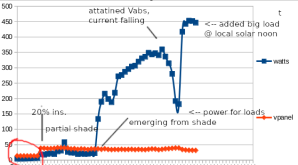Mythtesting: higher voltage for additional yield in the mornings
I am a fan of higher-voltage panels, serial panel configs,etc for several reasons. But I think there are some hyperbolic claims about their ability to collect extra power in the dawn/dusk shoulders.
The theory (and actuality), illustrated with 2x 100w 12v panels is that
-
solar panel voltage stabilizes above ~20% insolation; below that it falls off into a trough precipitously.
-
for our 12v panels wired in parallel, this “trough” voltage (not a real term) is below battery charging voltage then the panel cannot charge the battery; zero power is harvested in these low light conditions.
-
consider the same panels wired in series - their trough voltage is likely high enough to charge the battery; some power is harvested.
The matter at hand today is to find how much power can higher-voltage configurations harvest in the trough?
I will illustrate with some sloppy, illegible charts. I suck at those.

This is a crude graph of my systems output this morning from 0627 (when I woke up) to 1141 (when the system was in Absorption and acceptance had fallen off.
The blue line is output in watts and the orange line is panel voltage.

The section that concerns us is the circled red bit.
From 0627 to 0654 the sun was coming up and was entirely occluded by thick forest. You could not see where the sun was. This is the voltage trough: my panels have a Vmp of 36v but were running at ~13.57v, just enough to put ~5w into the deeply-cyled bank. 12v panels of the same materials would be running about 6.8v; not enough to charge the bank.
Is 5w > 0w? Yes. But remember this is for my 570w array; that’d be ~1.8w from our example 200w array.
How long does the trough last? At my location sunrise was 0523 and we emerged from the trough 91 minutes later. At 0523 it was making 2.05w and just before the voltage jump it was making 6.33W. Averaged over the entire period that would be 4.19w, and over 91 minutes that would give us 6.22wh. Again that’s for my 570w array, so it would be 2.18Wh, or about 0.17Ah at 12.5v for our 200w example array.
0.17Ah harvest is > zero, but I submit to you it is not enough on its own to drive someone to higher voltage panels.
bonus material
From this point on, 12v and 24v panels will both be out of the trough. But there are some other fun things going on with today’s observations.

The circled area here is the heavily dappled shade as the sun started peeking through the trees. 18w > 6w, so we can be grateful for it. But the shade really is messing stuff up.
At some point I will run all the panels in series to see what mppt can do with the shaded cells. I gave away my ladder just before I left so I’ll have to wait until I can get up top.

Once the sun is breaking free from the trees things really start to happen. There is some jitter, which I attribute to swaying tree limbs at the margins.

Once the trees are totally out the way we see a linear increase in power as the sun gets higher overhead and our yield increases.

As is common with overpaneled systems, the batteries are charged to Absorption voltage (Vabs) well before solar noon, so power harvest falls off drastically. It did not fall completely to the bottom because it was supporting about 175W in opportunity loads.
I did some calculations and estimated that at local solar noon (1257) the systems present max output should be ~456W: 570W rated power - 5% MPPT conversion losses - 15% cell temp derating at ambient 77F.
I set an alarm for 1250 and arranged a load; I’d heat water for green tea using a 300w immersion heater running through the inverter. This would be ~330w + my existing 175W loads, which should be more than the panels can make.

The red circle there is the stress test. Actual measurements were 442.69W, 452.8W, 451.9w, and 446.45w. Pretty danged close to the theoretical 456w.
Note that these noon power points were in line with the linear power increase from before. If I continued max power testing after noon it would have peaked and started the way back down.
